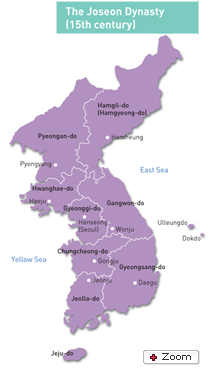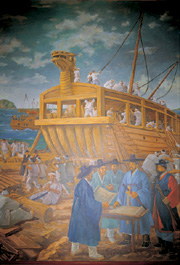
map of Joseon Dynasty (15th century)
In 1392, General Yi Seong-gye established a new dynasty called Joseon. The early rulers of Joseon, in order to counter the dominant Buddhist influence during the Goryeo period, supported Confucianism as the guiding philosophy of the kingdom.
The Joseon rulers governed the dynasty with a well-balanced political system. A civil service examination system was the main channel for recruiting government officials.
The examinations served as the backbone for social mobility and intellectual activity during the period. The Confucian-oriented society, however, highly valued academic learning while disdaining commerce and manufacturing.
During the reign of King Sejong the Great (1418-1450), Joseon's fourth monarch, Korea enjoyed an unprecedented flowering of culture and art. Under King Sejong's guidance, scholars at the royal academy created the Korean alphabet Hangeul. It was then called Hunminjeongeum, or "proper phonetic system to educate the people."
King Sejong's interest in astronomical science was comprehensive. Sundials, water clocks, celestial globes and astronomical maps were produced at his request. King Sejo (r.1455-1468) later established an institutional framework for government by publishing a compendium of legal codes, called Gyeongguk Daejeon.
In 1592, Japan invaded the peninsula to pave the way for its incursion into China. At sea, Admiral Yi Sun-sin (1545-1598), one of the most respected figures in Korean history, led a series of brilliant naval maneuvers against the Japanese, deploying the geobukseon (turtle ships), which are believed to be the world's first ironclad battleships.

drawing of geobukseon, which is believed to the world's first ironclad battleship
From the early 17th century, a movement advocating Silhak, or practical learning, gained considerable momentum among liberal-minded scholar-officials as a means of building a modern nation.
They strongly recommended agricultural and industrial improvements along with sweeping reforms in land distribution. The conservative government aristocrats, however, were not ready to accommodate such drastic change.
In the latter half of the Joseon era, government administration and the upper classes came to be marked by recurring factionalism. To rectify the undesirable political situation, King Yeongjo (r.1724-1776) eventually adopted a policy of impartiality. He was thus able to strengthen the royal authority and achieve political stability.
King Jeongjo (r.1776-1800) maintained the policy of impartiality and set up a royal library to preserve royal documents and records. He also initiated other political and cultural reforms. This period witnessed the blossoming of Silhak. A number of outstanding scholars wrote progressive works recommending agricultural and industrial reforms, but few of their ideas were adopted by the government.